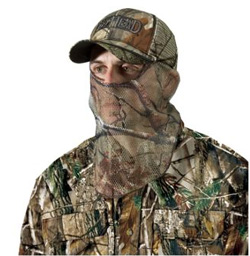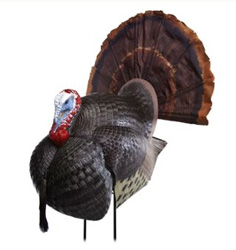
This is the second part of a two-part series covering the basics of turkey hunting, including specialized gear and safety. In Part 1, we covered the rules and tactics.
The Gear
Calls
 |
| Mouth diaphragm calls allow the hunter to make calls without moving his hands. |
As you can tell, being able to imitate the sounds that real turkeys make is the key to success, whether in spring or fall. Fortunately, there are a number of different calls available to replicate just about any sound a live turkey can make.
Diaphragm (mouth) turkey calls use small, horseshoe-shaped pieces of flat aluminum with one or more pieces of thin latex stretched across them to create a reed. These calls are probably the most popular type of call used by turkey hunters. This is because these mouth calls produce excellent imitations of a range of different turkey sounds, and don't require the hunter to make any noticeable hand movements while also allowing him to have both hands free to mount a gun or draw a bow. Although these calls are also the most difficult to learn to use and require the most practice, all turkey hunters should strive to master the diaphragm call.
Friction turkey calls are another popular type of call. These actually consist of two separate pieces, namely a round, flat box, called a sounding board, with a slate, glass, or aluminum surface, and a peg, or striker, with a pencil-like shaft of wood or some man-made material. By "scratching" the tip of the pen-shaped striker across the surface of the box, a number of different turkey calls can be imitated with excellent realism. The disadvantage of friction calls is that most require two hands to operate, and some also won't work when wet due to the materials used for the surface of the box and/or the head of the striker.
The other popular type of turkey call is the box call. A box call is simply a rectangular-shaped wooden box with a lid. By dragging the lightly-chalked bottom of the lid across the edges of the box, extremely realistic turkey sounds can be produced. These calls are very easy to use and can be heard from a long distance, but, as with slate calls, they require two hands and most types cannot be used in the rain.
Regardless of what type of call you purchase, if you don't know an experienced turkey hunter who can teach you how to use it, a good instructional CDs or videotape is another essential piece of equipment. Play the tape over and over until you can reproduce most of the key sounds, and then practice, and practice some more. But don't just start practicing the night before opening day. Turkeys have excellent hearing, and can tell a good call from a poor one, which is why many hunters practice their calling year round.
Although there are other types of mouth and friction calls available, most hunters use one of the above calls. In fact, many hunters use a number of different calls, of different varieties, in order to imitate the sound of different birds. As you can imagine, it can be difficult to carry such an assortment of different calls into the field. That is why most turkey hunters wear a turkey vest.
The key feature of a good turkey vest is the number of different pockets that it contains for storing all manner of different turkey calls. A turkey vest can also have a built-in back and/or seat cushion, as well as a game pouch for carrying your turkey.
Camouflage Hunting Clothing
 |
| Because turkeys can see color, it's important to cover every movement, including head and neck. |
Unlike many of the game species that hunters pursue, turkeys can see color, and have excellent visual acuity as well. That means that unnecessary movement should always be avoided, and full head-to-toe camouflage hunting clothing is required to cover up all necessary movement. Face and hands should also be camouflaged. This is especially true for bowhunters, since more movement is required to lift, draw and aim a bow than with a shotgun.
But not all camouflage is the same. Army surplus jungle camouflage is better than nothing, but there are dozens of superior camo patterns available to today's turkey hunters. Regardless of where you hunt, there is a camo pattern to match, and a camo pattern that matches the terrain and cover you will be hunting in will do a better job of breaking up your outline and concealing your movements.
Camo colors can be matched as well. During the early spring, when new vegetation and leaves have not yet sprouted, a pattern with more browns and greys is more effective than one that is predominantly green. This is also true for fall turkey hunting. However, a pattern containing more greens will blend in much better as the spring progresses.
Guns & Bows
Guns or bows must accord to local regulations, which usually mandate shotguns of between 10 and 20 gauge, loaded with shot sizes of between #4 and #6, and bows of similar pound pull as those required for hunting deer. Some jurisdictions also allow the use of rifles and handguns during their fall seasons. Calibers starting with the .22 centerfires on up to the various deer-class cartridges are appropriate.
When hunting with a shotgun, always aim for the turkey's head and neck. Never shoot at the thick and boney body of a turkey, as it will usually result in just a wounded bird. Because a turkey's head and neck is a small target — about the size of your wrist and fist — tight turkey chokes are the way to go. As a result, many hunters opt for iron sights and even scopes on tight-shooting turkey guns. However; make sure that you pattern your shotgun in advance to see how it shoots, and try different ammunition if you are not happy with the results.
When you do get a big gobbler in your shotgun's sights, try to avoid taking the shot while the bird is all puffed up and strutting. During such posture, the gobbler will actually pull his vulnerable head and neck down and into his chest, partially shielding the target area. Instead, wait for him to straighten up and stick his head up, offering a much better target.
Bowhunters should use razor-sharp broadheads suitable for deer, and aim for the turkey's vital internal organs.
Turkey Hunting Accessories
Portable or natural hunting blinds are also popular with some hunters. The beauty of a blind is that it conceals all movement, especially when the bird is in close and you're getting ready to shoot. Blinds are very popular with bowhunters, as raising, drawing and aiming a bow requires much more movement than a shotgun does. Doing all of that without being spotted can be very difficult, especially when you are in view of more than one bird.
 |
| Decoys can add a visual confirmation of what the turkey is hearing. |
Besides a small stool and/or seat cushion to sit on, the final piece of equipment that most turkey hunters rely on is a decoy or two. An imitation hen or jake serves to not only add a visual confirmation of what the gobbler is hearing, but also helps to focus the turkey's attention away from the hunter during the final key moments before the shot.
Decoys should be used with caution, however, especially while hunting on public land. Although calling a turkey into shooting range is what it's all about, and not to mention the fact that they are just too wary to be stalked with any real degree of success, some hunters may spot your decoy, mistake it for a live bird, and decide to try to sneak up on it. Should you see another hunter stalking your decoy, quickly speak up in a firm voice. This brings us to a word on turkey hunting safety.
Hunting Safety
When setting up in a calling location, find a nice tree to sit against, making sure that the tree is at least as wide as your shoulders, and make sure that you have good visibility to spot approaching hunters, as well as approaching turkeys.
Never wear visible items of clothing in white, red or blue, as these colors can be mistaken for parts of a turkey. Similarly, when you bag your bird and are carrying it out of the field, make sure that the bird is either completely concealed or that you and the bird are marked with a sufficient amount of hunter orange to alert other hunters.
Don't let what may seem like a lot of complicated gear, rules and tactics keep you from trying this exciting sport. A little bit of basic knowledge will help you sort through the confusion, and you'll soon discover what great sport turkey hunting is.
- 9153 views

